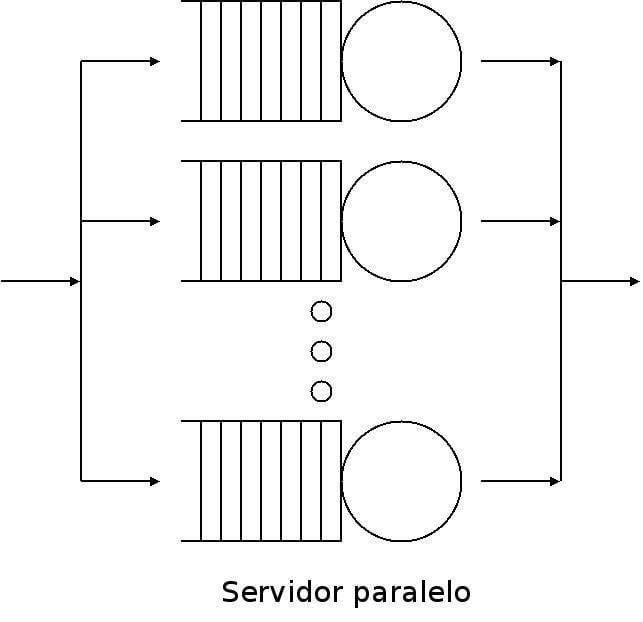 | ||
Queueing theory is the mathematical study of waiting lines, or queues. In queueing theory, a model is constructed so that queue lengths and waiting time can be predicted. Queueing theory is generally considered a branch of operations research because the results are often used when making business decisions about the resources needed to provide a service.
Contents
- Spelling
- Single queueing nodes
- Service disciplines
- Queueing networks
- Example of MM1
- Routing algorithms
- Mean field limits
- Fluid limits
- Heavy trafficdiffusion approximations
- References
Queueing theory has its origins in research by Agner Krarup Erlang when he created models to describe the Copenhagen telephone exchange. The ideas have since seen applications including telecommunication, traffic engineering, computing and the design of factories, shops, offices and hospitals as well as in project management.
Spelling
The spelling "queueing" over "queuing" is typically encountered in the academic research field. In fact, one of the flagship journals of the profession is named Queueing Systems.
Single queueing nodes
Single queueing nodes are usually described using Kendall's notation in the form A/S/C where A describes the time between arrivals to the queue, S the size of jobs and C the number of servers at the node. Many theorems in queueing theory can be proved by reducing queues to mathematical systems known as Markov chains, first described by Andrey Markov in his 1906 paper.
Agner Krarup Erlang, a Danish engineer who worked for the Copenhagen Telephone Exchange, published the first paper on what would now be called queueing theory in 1909. He modeled the number of telephone calls arriving at an exchange by a Poisson process and solved the M/D/1 queue in 1917 and M/D/k queueing model in 1920. In Kendall's notation:
The M/M/1 queue is a simple model where a single server serves jobs that arrive according to a Poisson process and have exponentially distributed service requirements. In an M/G/1 queue the G stands for general and indicates an arbitrary probability distribution. The M/G/1 model was solved by Felix Pollaczek in 1930, a solution later recast in probabilistic terms by Aleksandr Khinchin and now known as the Pollaczek–Khinchine formula.
After the 1940s queueing theory became an area of research interest to mathematicians. In 1953 David George Kendall solved the GI/M/k queue and introduced the modern notation for queues, now known as Kendall's notation. In 1957 Pollaczek studied the GI/G/1 using an integral equation. John Kingman gave a formula for the mean waiting time in a G/G/1 queue: Kingman's formula.
The matrix geometric method and matrix analytic methods have allowed queues with phase-type distributed inter-arrival and service time distributions to be considered.
Problems such as performance metrics for the M/G/k queue remain an open problem.
Service disciplines
Various scheduling policies can be used at queuing nodes:
Queueing networks
Networks of queues are systems in which a number of queues are connected by customer routing. When a customer is serviced at one node it can join another node and queue for service, or leave the network. For a network of m the state of the system can be described by an m–dimensional vector (x1,x2,...,xm) where xi represents the number of customers at each node.
The first significant results in this area were Jackson networks, for which an efficient product-form stationary distribution exists and the mean value analysis which allows average metrics such as throughput and sojourn times to be computed. If the total number of customers in the network remains constant the network is called a closed network and has also been shown to have a product–form stationary distribution in the Gordon–Newell theorem. This result was extended to the BCMP network where a network with very general service time, regimes and customer routing is shown to also exhibit a product-form stationary distribution. The normalizing constant can be calculated with the Buzen's algorithm, proposed in 1973.
Networks of customers have also been investigated, Kelly networks where customers of different classes experience different priority levels at different service nodes. Another type of network are G-networks first proposed by Erol Gelenbe in 1993: these networks do not assume exponential time distributions like the classic Jackson Network.
Example of M/M/1
Routing algorithms
In discrete time networks where there is a constraint on which service nodes can be active at any time, the max-weight scheduling algorithm chooses a service policy to give optimal throughput in the case that each job visits only a single service node. In the more general case where jobs can visit more than one node, backpressure routing gives optimal throughput.
A network scheduler must choose a queuing algorithm, which affects the characteristics of the larger network.
Mean field limits
Mean field models consider the limiting behaviour of the empirical measure (proportion of queues in different states) as the number of queues (m above) goes to infinity. The impact of other queues on any given queue in the network is approximated by a differential equation. The deterministic model converges to the same stationary distribution as the original model.
Fluid limits
Fluid models are continuous deterministic analogs of queueing networks obtained by taking the limit when the process is scaled in time and space, allowing heterogeneous objects. This scaled trajectory converges to a deterministic equation which allows the stability of the system to be proven. It is known that a queueing network can be stable, but have an unstable fluid limit.
Heavy traffic/diffusion approximations
In a system with high occupancy rates (utilisation near 1) a heavy traffic approximation can be used to approximate the queueing length process by a reflected Brownian motion, Ornstein–Uhlenbeck process or more general diffusion process. The number of dimensions of the RBM is equal to the number of queueing nodes and the diffusion is restricted to the non-negative orthant.
